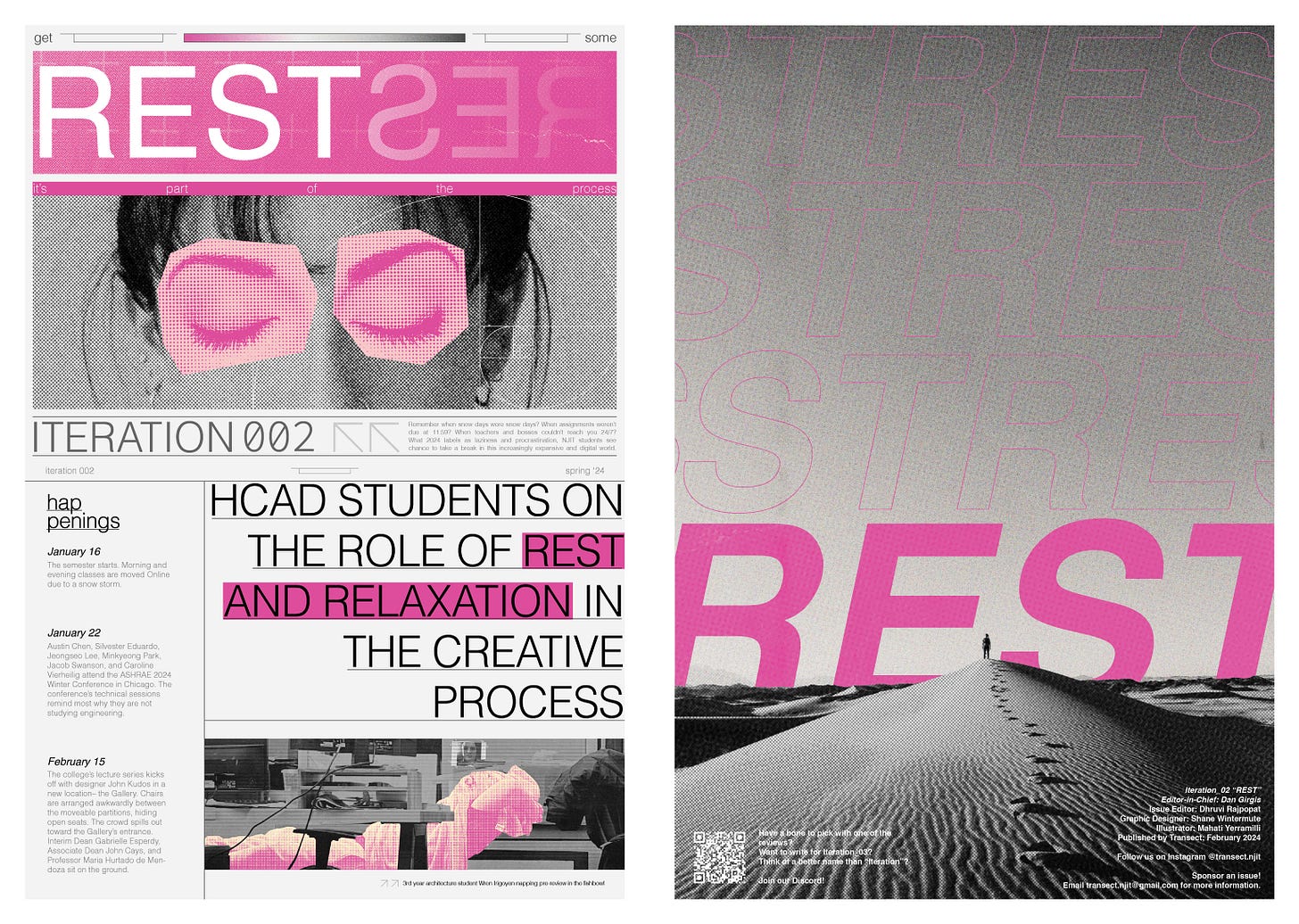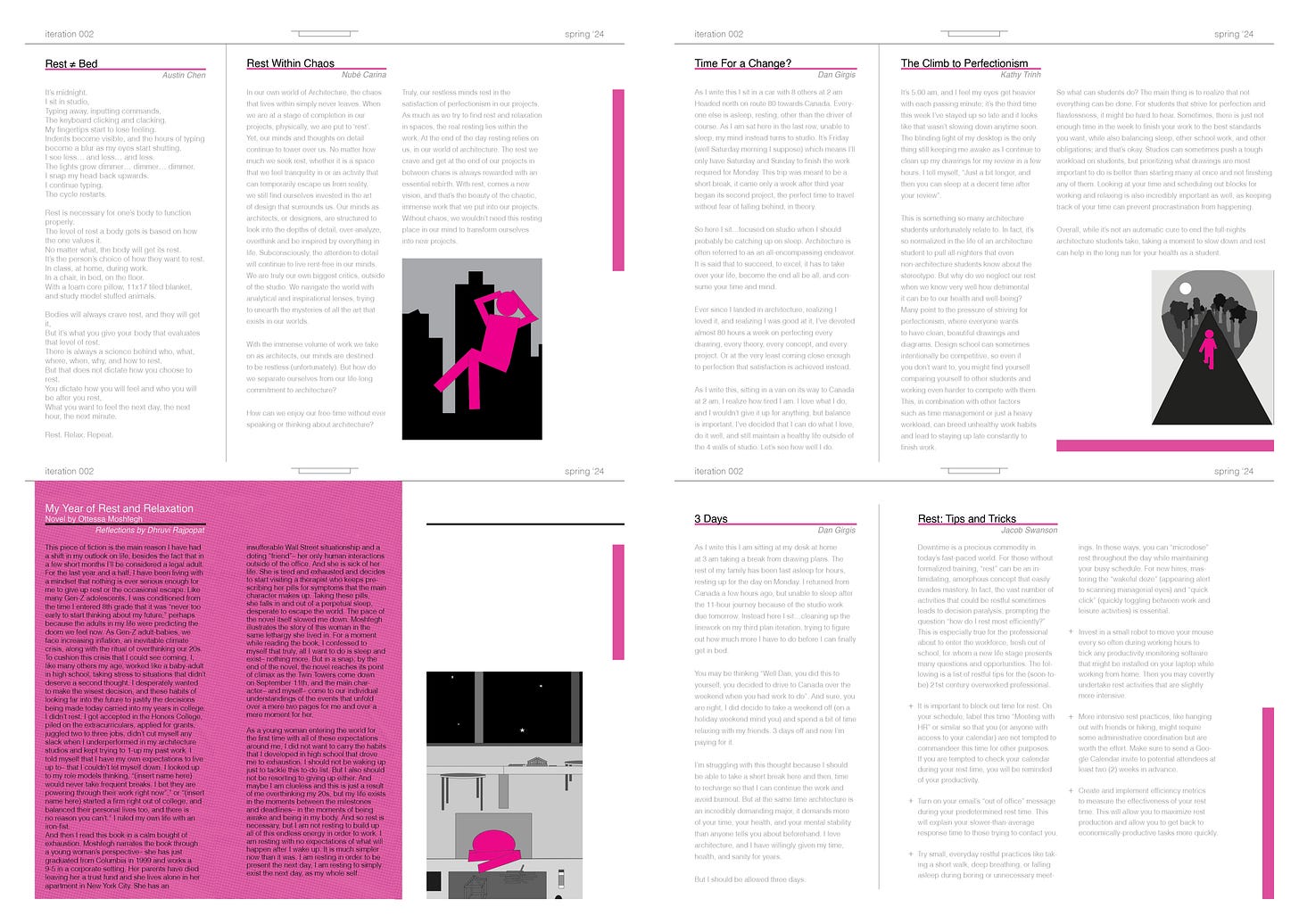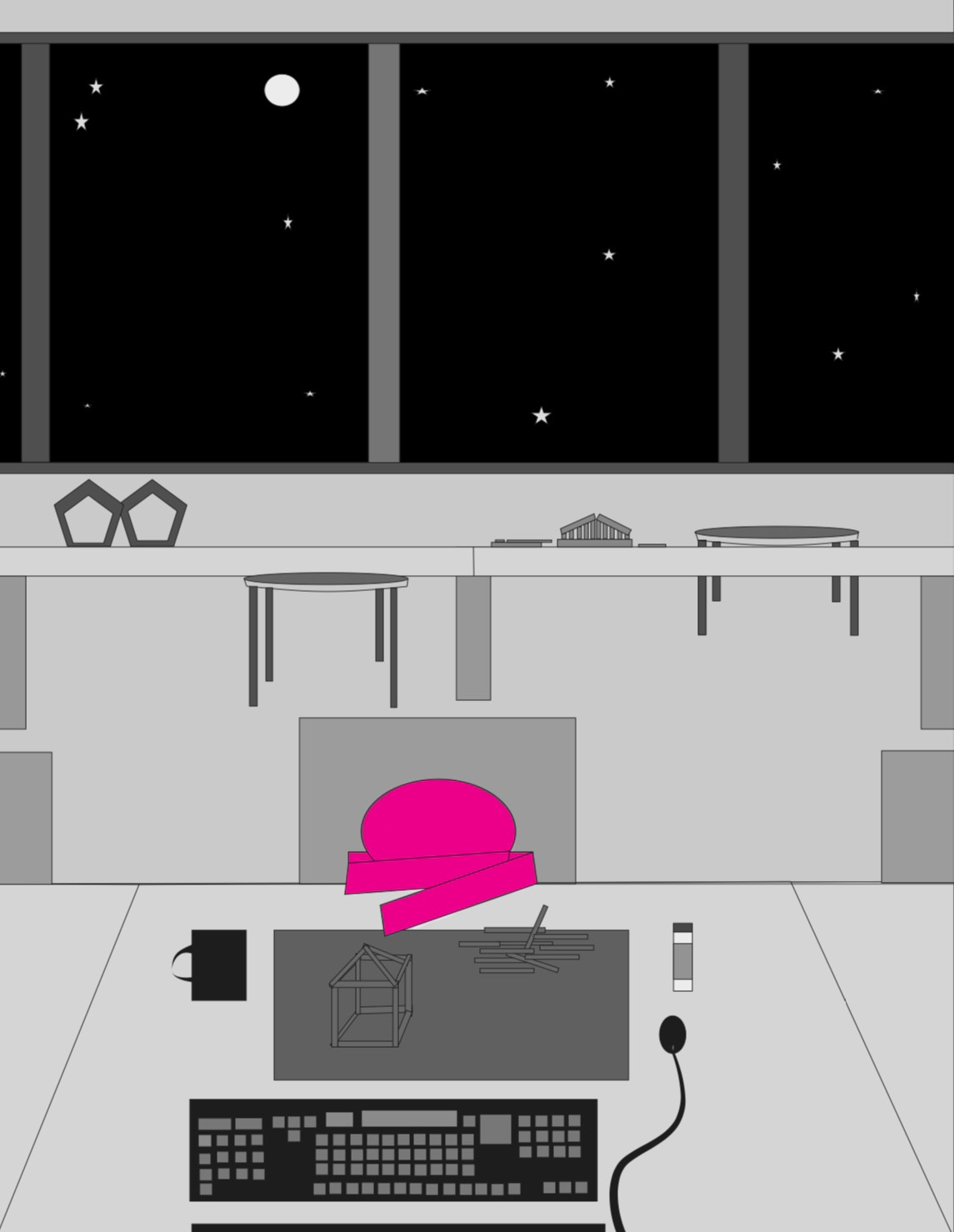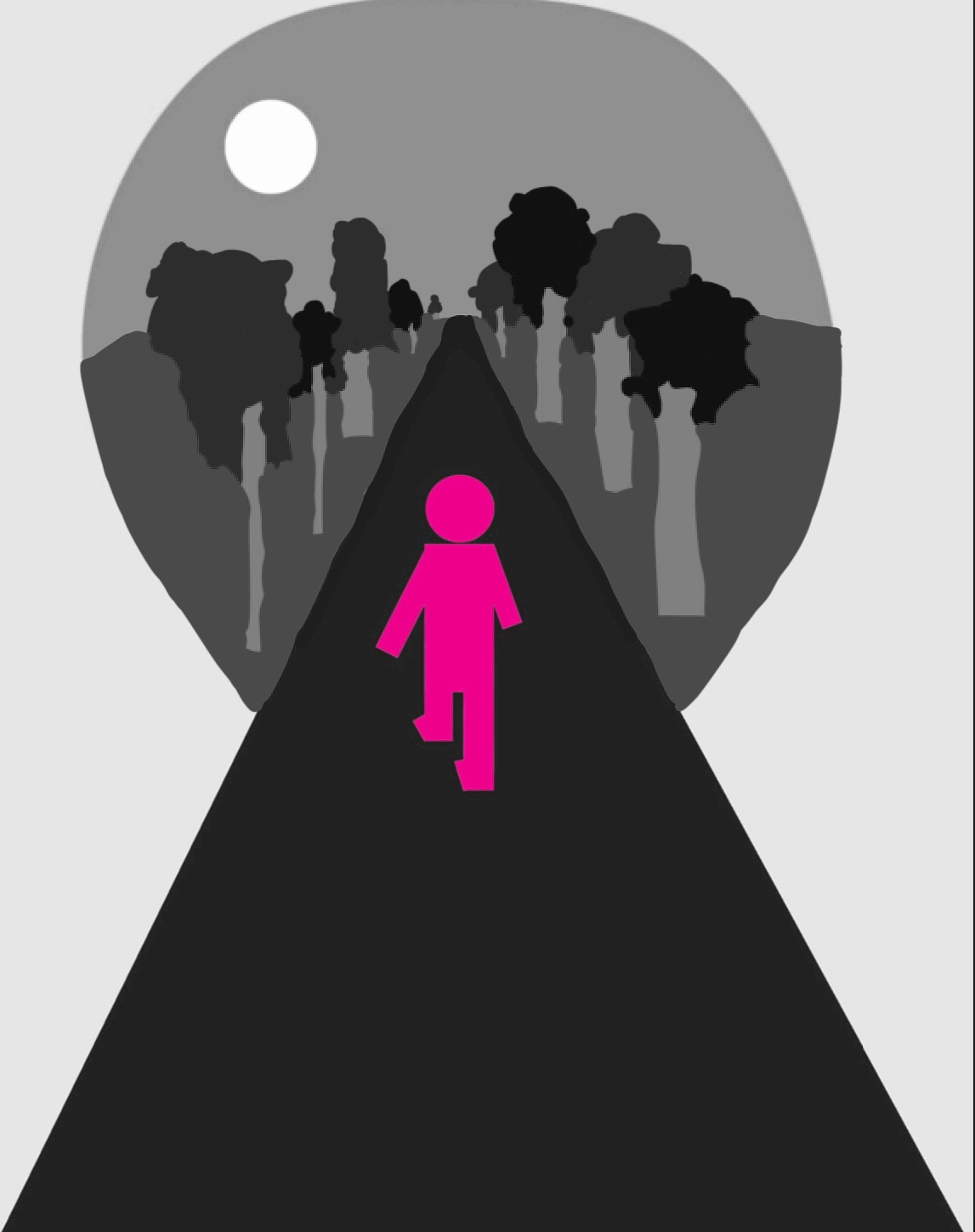Iteration_02: "Rest"
Architecture students wonder what 'Rest' feels like
“Rest”
Remember when snow days were snow days? When assignments weren’t due at 11:59? When teachers and bosses couldn’t reach you 24/7? What 2024 labels as laziness and procrastination, NJIT students see chance to take a break in this increasingly expansive and digital world.
Editor-in-Chief: Daniel Girgis
Issue Editor: Dhruvi Rajpopat
Graphic Designer: Shane Wintermute
Illustrator: Mahati Yerramilli
Contributors: Nubé Carina, Austin Chen, Dan Girgis, Dhruvi Rajpopat, Jacob Swanson, Kathy Trinh
My Year of Rest and Relaxation
Novel by Ottessa Moshfegh
Reflections by Dhruvi Rajpopat
This piece of fiction is the main reason I have had a shift in my outlook on life, besides the fact that in a few short months I’ll be considered a legal adult. For the last year and a half, I have been living with a mindset that nothing is ever serious enough for me to give up rest or the occasional escape. Like many Gen-Z adolescents, I was conditioned from the time I entered 8th grade that it was “never too early to start thinking about my future,” perhaps because the adults in my life were predicting the doom we feel now. As Gen-Z adult-babies, we face increasing inflation, an inevitable climate crisis, along with the ritual of overthinking our 20s. To cushion this crisis that I could see coming, I, like many others my age, worked like a baby-adult in high school, taking stress to situations that didn’t deserve a second thought. I desperately wanted to make the wisest decision, and these habits of looking far into the future to justify the decisions being made today carried into my years in college. I didn’t rest. I got accepted in the Honors College, piled on the extracurriculars, applied for grants, juggled two to three jobs, didn’t cut myself any slack when I underperformed in my architecture studios and kept trying to 1-up my past work. I told myself that I have my own expectations to live up to– that I couldn’t let myself down. I looked up to my role models thinking, “(insert name here) would never take frequent breaks. I bet they are powering through their work right now”,” or “(insert name here) started a firm right out of college, and balanced their personal lives too, and there is no reason you can’t.” I ruled my own life with an iron-fist.
And then I read this book in a calm bought of exhaustion. Moshfegh narrates the book through a young woman’s perspective– she has just graduated from Columbia in 1999 and works a 9-5 in a corporate setting. Her parents have died leaving her a trust fund and she lives alone in her apartment in New York City. She has an insufferable Wall Street situationship and a doting “friend”– her only human interactions outside of the office. And she is sick of her life. She is tired and exhausted and decides to start visiting a therapist who keeps prescribing her pills for symptoms that the main character makes up. Taking these pills, she falls in and out of a perpetual sleep, desperate to escape the world. The pace of the novel itself slowed me down. Moshfegh illustrates the story of this woman in the same lethargy she lived in. For a moment while reading the book, I confessed to myself that truly, all I want to do is sleep and exist– nothing more. But in a snap, by the end of the novel, the novel reaches its point of climax as the Twin Towers come down on September 11th, and the main character– and myself– come to our individual understandings of the events that unfold over a mere two pages for me and over a mere moment for her.
As a young woman entering the world for the first time with all of these expectations around me, I did not want to carry the habits that I developed in high school that drove me to exhaustion. I should not be waking up just to tackle this to-do list. But I also should not be resorting to giving up either. And maybe I am clueless and this is just a result of me overthinking my 20s, but my life exists in the moments between the milestones and deadlines– in the moments of being awake and being in my body. And so rest is necessary, but I am not resting to build up all of this endless energy in order to work. I am resting with no expectations of what will happen after I wake up. It is much simpler now than it was. I am resting in order to be present the next day, I am resting to simply exist the next day, as my whole self.
Rest ≠ Bed
Austin Chen
It’s midnight.
I sit in studio,
Typing away, inputting commands,
The keyboard clicking and clacking.
My fingertips start to lose feeling.
Indents become visible, and the hours of typing become a blur as my eyes start shutting.
I see less… and less… and less.
The lights grow dimmer… dimmer… dimmer.
I snap my head back upwards.
I continue typing.
The cycle restarts.
Rest is necessary for one’s body to function properly.
The level of rest a body gets is based on how the one values it.
No matter what, the body will get its rest.
It’s the person’s choice of how they want to rest.
In class, at home, during work.
In a chair, in bed, on the floor.
With a foam core pillow, 11x17 tiled blanket, and study model stuffed animals.
Bodies will always crave rest, and they will get it,
But it’s what you give your body that evaluates that level of rest.
There is always a science behind who, what, where, when, why, and how to rest,
But that does not dictate how you choose to rest.
You dictate how you will feel and who you will be after you rest,
What you want to feel the next day, the next hour, the next minute.
Rest. Relax. Repeat.
Rest Within Chaos
Nubé Carina
In our own world of Architecture, the chaos that lives within simply never leaves. When we are at a stage of completion in our projects, physically, we are put to ‘rest’. Yet, our minds and thoughts on detail continue to tower over us. No matter how much we seek rest, whether it is a space that we feel tranquility in or an activity that can temporarily escape us from reality, we still find ourselves invested in the art of design that surrounds us. Our minds as architects, or designers, are structured to look into the depths of detail, over-analyze, overthink and be inspired by everything in life. Subconsciously, the attention to detail will continue to live rent-free in our minds. We are truly our own biggest critics, outside of the studio. We navigate the world with analytical and inspirational lenses, trying to unearth the mysteries of all the art that exists in our worlds.
With the immense volume of work we take on as architects, our minds are destined to be restless (unfortunately). But how do we separate ourselves from our life-long commitment to architecture?
How can we enjoy our free-time without ever speaking or thinking about architecture?
Truly, our restless minds rest in the satisfaction of perfectionism in our projects. As much as we try to find rest and relaxation in spaces, the real resting lies within the work. At the end of the day resting relies on us, in our world of architecture. The rest we crave and get at the end of our projects in between chaos is always rewarded with an essential rebirth. With rest, comes a new vision, and that’s the beauty of the chaotic, immense work that we put into our projects. Without chaos, we wouldn’t need this resting place in our mind to transform ourselves into new projects.
Time For a Change?
Dan Girgis
As I write this I sit in a car with 8 others at 2 am Headed north on route 80 towards Canada. Everyone else is asleep, resting, other than the driver of course. As I am sat here in the last row, unable to sleep, my mind instead turns to studio. It’s Friday (well Saturday morning I suppose) which means I’ll only have Saturday and Sunday to finish the work required for Monday. This trip was meant to be a short break, it came only a week after third year began its second project, the perfect time to travel without fear of falling behind, in theory.
So here I sit…focused on studio when I should probably be catching up on sleep. Architecture is often referred to as an all-encompassing endeavor. It is said that to succeed, to excel, it has to take over your life, become the end all be all, and consume your time and mind.
Ever since I landed in architecture, realizing I loved it, and realizing I was good at it, I’ve devoted almost 80 hours a week on perfecting every drawing, every theory, every concept, and every project. Or at the very least coming close enough to perfection that satisfaction is achieved instead.
As I write this, sitting in a van on its way to Canada at 2 am, I realize how tired I am. I love what I do, and I wouldn’t give it up for anything, but balance is important. I’ve decided that I can do what I love, do it well, and still maintain a healthy life outside of the 4 walls of studio. Let’s see how well I do.
3 Days
Daniel Girgis
As I write this I am sitting at my desk at home at 3 am taking a break from drawing plans. The rest of my family has been fast asleep for hours, resting up for the day on Monday. I returned from Canada a few hours ago, but unable to sleep after the 11-hour journey because of the studio work due tomorrow. Instead here I sit…cleaning up the line-work on my third plan iteration, trying to figure out how much more I have to do before I can finally get in bed.
You may be thinking “Well Dan, you did this to yourself, you decided to drive to Canada over the weekend when you had work to do”. And sure, you are right, I did decide to take a weekend off (on a holiday weekend mind you) and spend a bit of time relaxing with my friends. 3 days off and now I’m paying for it.
I’m struggling with this thought because I should be able to take a short break here and then, time to recharge so that I can continue the work and avoid burnout. But at the same time architecture is an incredibly demanding major, it demands more of your time, your health, and your mental stability than anyone tells you about beforehand. I love architecture, and I have willingly given my time, health, and sanity for years.
But I should be allowed three days.
Rest: Tips and Tricks
Jacob Swanson
Downtime is a precious commodity in today’s fast-paced world. For those without formalized training, “rest” can be an intimidating, amorphous concept that easily evades mastery. In fact, the vast number of activities that could be restful sometimes leads to decision paralysis, prompting the question “how do I rest most efficiently?” This is especially true for the professional about to enter the workforce, fresh out of school, for whom a new life stage presents many questions and opportunities. The following is a list of restful tips for the (soon-to-be) 21st century overworked professional.
·It is important to block out time for rest. On your schedule, label this time “Meeting with HR” or similar so that you (or anyone with access to your calendar) are not tempted to commandeer this time for other purposes. If you are tempted to check your calendar during your rest time, you will be reminded of your productivity.
·Turn on your email’s “out of office” message during your predetermined rest time. This will explain your slower-than-average response time to those trying to contact you.
·Try small, everyday restful practices like taking a short walk, deep breathing, or falling asleep during boring or unnecessary meetings. In these ways, you can “microdose” rest throughout the day while maintaining your busy schedule. For new hires, mastering the “wakeful doze” (appearing alert to scanning managerial eyes) and “quick click” (quickly toggling between work and leisure activities) is essential.
·Invest in a small robot to move your mouse every so often during working hours to trick any productivity monitoring software that might be installed on your laptop while working from home. Then you may covertly undertake rest activities that are slightly more intensive.
·More intensive rest practices, like hanging out with friends or hiking, might require some administrative coordination but are worth the effort. Make sure to send a Google Calendar invite to potential attendees at least two (2) weeks in advance.
·Create and implement efficiency metrics to measure the effectiveness of your rest time. This will allow you to maximize rest production and allow you to get back to economically-productive tasks more quickly.
The Climb to Perfectionism
Kathy Trinh
It’s 5:00 am, and I feel my eyes get heavier with each passing minute; it’s the third time this week I’ve stayed up so late and it looks like that wasn’t slowing down anytime soon. The blinding light of my desktop is the only thing still keeping me awake as I continue to clean up my drawings for my review in a few hours. I tell myself, “Just a bit longer, and then you can sleep at a decent time after your review”.
This is something so many architecture students unfortunately relate to. In fact, it’s so normalized in the life of an architecture student to pull all-nighters that even non-architecture students know about the stereotype. But why do we neglect our rest when we know very well how detrimental it can be to our health and well-being? Many point to the pressure of striving for perfectionism, where everyone wants to have clean, beautiful drawings and diagrams. Design school can sometimes intentionally be competitive, so even if you don’t want to, you might find yourself comparing yourself to other students and working even harder to compete with them. This, in combination with other factors such as time management or just a heavy workload, can breed unhealthy work habits and lead to staying up late constantly to finish work.
So what can students do? The main thing is to realize that not everything can be done. For students that strive for perfection and flawlessness, it might be hard to hear. Sometimes, there is just not enough time in the week to finish your work to the best standards you want, while also balancing sleep, other school work, and other obligations; and that’s okay. Studios can sometimes push a tough workload on students, but prioritizing what drawings are most important to do is better than starting many at once and not finishing any of them. Looking at your time and scheduling out blocks for working and relaxing is also incredibly important as well, as keeping track of your time can prevent procrastination from happening.
Overall, while it’s not an automatic cure to end the full-nights architecture students take, taking a moment to slow down and rest can help in the long run for your health as a student.
Happenings
January 16: The semester starts. Morning and evening classes are moved Online due to a snow storm.
January 22: Austin Chen, Silvester Eduardo, Jeongseo Lee, Minkyeong Park, Jacob Swanson, and Caroline Vierheilig attend the ASHRAE 2024 Winter Conference in Chicago. The conference’s technical sessions remind most why they are not studying engineering.
February 15: The college’s lecture series kicks off with designer John Kudos in a new location– the Gallery. Chairs are arranged awkwardly between the moveable partitions, hiding open seats. The crowd spills out toward the Gallery’s entrance. Interim Dean Gabrielle Esperdy, Associate Dean John Cays, and Professor Maria Hurtado de Mendoza sit on the ground.
Have a bone to pick with one of the reviews?
Want to write for Iteration_03?
Think of a better name than “Iteration”?
Join our Discord!
Follow us on our Instagram!
Sponsor an Issue!






